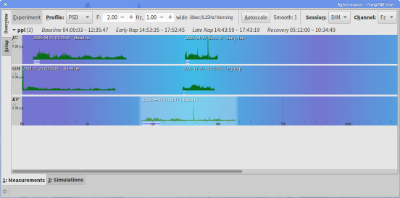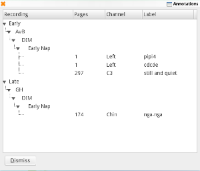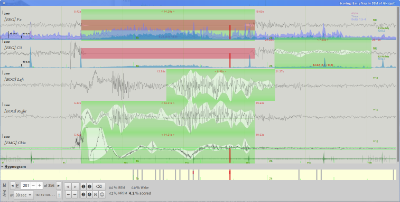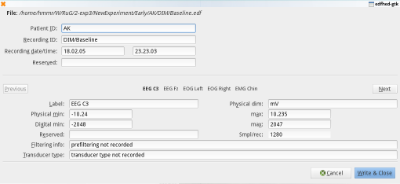Aghermann
Aghermann is a program designed to run Process S simulations on Slow-Wave Activity profiles from (human) EEG recordings as outlined in Achermann et al (1993). In this capacity, Aghermann produces a set of sleep homeostat parameters which can be used to describe and differentiate individual sleepers, such as short vs long sleepers, early vs late, etc.
Table of Contents
1 Sources and availability
The latest version is 1.1.2, released 2017-01-03 (ChangeLog). There is little onging work since version 1.0, most of which is catching up with new build requirements in Debian or eventual deprecations coming our way from GTK. Unless and until someone comes along with compellingly interesting ideas, it is considered feature complete.
As of version 0.4.4 (2012-01-07), Aghermann is included in Debian sid (unstable). So you might only wish to build from sources if you want to squeeze the extra couple of percent in speed -O3 will probably yield (or if your distro is of non-Debian lineage).
In 2020, I have given the upkeep of Aghermann to good folks over at Debian-med. If you find aghermann from my tree does no longer build natively on your system, check out their patches.
There is an ebuild, too, in gentoo ‘science’ overlay, available since 2015-02-18.
The project’s public Git repositories are hosted at home, on GitLab, on Debian servers and, historically, also at SourceForge.
2 Features
Sleep experiment recording manager
EDF signal viewing and scoring facility
Artifact detection
Artifact detection comes as a side-effect in the computation of EEG Microcontinuity, and may or may not meet your expectations. Most parameters affecting artifact detection are exposed for your tuning. Run with default settings, it tends to be a little too eager at the task, though.
Filters
Butterworth Low-pass, high-pass and band-pass filters are available as well as band-stop ("notch") filters at 50 and 60 Hz.
Manual artifact marking
EEG signals can be manually filtered for artifacts. The PSD analysis is then performed on cleaner pages, greatly enhancing the resulting spectral power profile.
Independent Component Analysis
Cairo subpixel drawing
All minute details exposed thanks to cairo subpixel drawing (alternatively, signal can be downsampled for faster redraw).
Almost all drawing areas can be saved as SVG files.
Pattern finding
A pattern is characterized by a certain, band-pass filtered, target frequency component, its envelope (a tangential line connecting local extrema over a certain range), and a density function of zerocrossings of signal derivative (with variable sigma and sampling interval, interpolated). Using these criteria and some tuning, one can find occurrences of a pattern (say, a K-complex) in the signal.
Patterns can be saved, and searched for in other subjects, and/or in other experiments.
Phase difference between channels
This is an experimental feature which can hint at the direction of propagation of EEG waves in a certain frequency band. It is determined as a shift of one signal's band-passed component against another such that the difference between them is minimal.
Automatic scoring
It has been considered but never matured enough to overcome the distrust of at least one well-to-do sleep researcher. The bright solution I found is, however, to delegate it to the user, one much desirable side effect of this being, I will not be blamed, let alone laughed at, for my scoring algorithm performing like speech recognition in Windows 95.
- Manual scoring
Recordings can be conveniently scored manually; scores can be imported/exported in plain ASCII.
- Automated scoring
Scoring can also be scripted, in Lua.
To enable such scripted scoring, you have access, from within Lua, to the following functions (in lua-like pseudocode):
function get_channel_list () return n_channels, ch1, ch2, ... end function get_channel_list_of_type (type) return n_channels, ch1, ch2, ... end function get_channel_data (channel) return n_full_pages, n_total_pages, pagesize, samplerate end function get_psd (channel, start_page, end_page_inclusive, freq_min, freq_max) return vector_of_psd_values_in_given_range end function get_mc (channel, start_page, end_page_inclusive, freq0, unused) return vector_of_mc_values_at_given_freq end function get_swu (channel, start_page, end_page_inclusive, freq0, unused) return vector_of_swu_values_at_given_freq end function get_signal_envelope (channel, page, scope, dt) return vector_of_signal_envelope_breadth_values_taken_at_dt_intervals end function get_page_dirty (channel, page) return portion_0thru1_of_signal_marked_as_artifact end
And, to score a page, use score (page, score).
The above functions are defined in basic_score.lua, which appears as a default, system scoring profile. This script is barely useful in this form (it only takes into accout the first EEG channel, and only tries to detect NREM). You are encouraged to duplicate the relevant boilerplate from it to create a more advanced scoring script.
SWA profiles
Three kinds of SWA profiles available for Achermann model simulations:
- Power spectrum density (PSD), which can be obtained in bins of 0.25, 0.5 and 1 Hz and combined into larger frequency ranges, or conventional bands (delta, gamma etc).
- EEG Microcontinuity "lite".
- Slow Wave Upswing (SWU).
Basic sleep metrics
Process S simulations following Achermann et al, 1993
| For description of the underlying model, refer to the original article. and to my PhD dissertation. For a brief recapitulation, see here. | 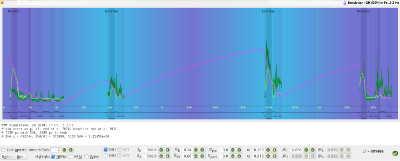 |
Optimisation is performed using the simulated annealing method from GSL.
Data export
- Signal, SWA profiles and model parameters can be exported as tsv files for further stats.
- All graphic presentations can be saved in SVG format.
EDF header viewer/editor
EDF channel converter/mixer
Another simple terminal tool is edfcat, with two basic operations: (1) convert an ascii csv/tsv file into edf, and (2) drop channels from an edf file. Refer to its man page for details. More operations are planned.
3 Notes on security and accessibility
- There is no consideration specially given to potential security issues Aghermann might run into when used to open a corrupt or laced EDF file. If, for example, the header says there are more (or less) data records than there actually are in the file, Aghermann may still behave in a way one would consider correct or natural, but it may just segfault as likely as not. Your principal rule here is, trust your sources.
- Secondly, I have heeded no advice whatsoever on human interface guidelines as, for example, adopted by Gnome; the controls are designed in a way I considered the most efficient towards a better workflow, but only after you read the relevant man pages. And I see no purpose in an obligatory, but empty, menu bar that occupies space otherwise so precious when you have five waveforms cramped into your netbook screen.
- Likewise, if you have no mouse, there's no practical possibility to interact with the program.
- (In GTK+ menus, pressing space helpfully toggles a checkbox or selects a radio item but leaves the menu displayed, unlike clicking on the item or pressing Enter. This saved me a few dialog boxes along the way.)
4 Feedback/bugreports
Should you find Aghermann useful (in its scoring capacity only, or even to the full extent of its modelling sophistication), comments and suggestions are welcome (preferably on aghermann@lists.sourceforge.net). Wishlist features can be considered as a matter of course.
